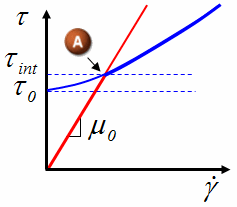Modeling non-Newtonian fluid
Non-Newtonian fluids
In non-Newtonian fluids, the shear stress of the fluid is not proportional to the rate of deformation. Therefore, the viscosity is no longer a constant and an additional model is required to model viscosity.
You can use one of the following models in accordance with fluid behavior:
- Power-Law model for fluids with dilatant, pseudo-plastic, and similar behaviors.
- Herschel-Bulkley modelfor fluids with Bingham plastic, viscoplastic, and similar behaviors.
- Carreau model that is a generalized model that behaves as Newtonian at low shear rate and non-Newtonian for high shear rates.
Power-Law model
The fluid viscosity, μ, of a Power-Law fluid is defined in the flow solver using the following equation:
where:
- K is the consistency index.
- is the shear rate.
- n is the power law index.
- T0 is the reference temperature.
- T is the fluid temperature.
- μmin is the minimum viscosity limit.
- μmax is the maximum viscosity limit.
Herschel-Bulkley model
The fluid viscosity, μ, of a Herschel-Bulkley fluid is modelled in the flow solver using the following equation:
where:
- K is the consistency index.
- is the shear rate.
- n is the power law index.
- τ0 is the yield stress.
- τint is the stress value at the intersection point A shown in the following figure.
- μ0 is the yield viscosity or plastic viscosity.

To smooth convergence, a fluid defined with Herschel-Bulkley model, behaves like a Newtonian fluid until the local shear stress reaches intersect (A), shown as the red curve. The yield viscosity, μ0, is a mathematical artefact introduced to improve convergence of the Herschel-Bulkley model when the stress is less than the yield stress. The blue curve shows the non-Newtonian Herschel-Bulkley behavior after intersect (A).
Carreau model
The fluid viscosity, μ, of a Carreau fluid is defined in the flow solver using the following equation:
where:
- λ is the time constant.
- is the shear rate.
- n is the power law index.
- T0 is the reference temperature.
- T is the fluid temperature.
- μ∞ is the infinite-shear viscosity.
- μ0 is the zero-shear viscosity.
